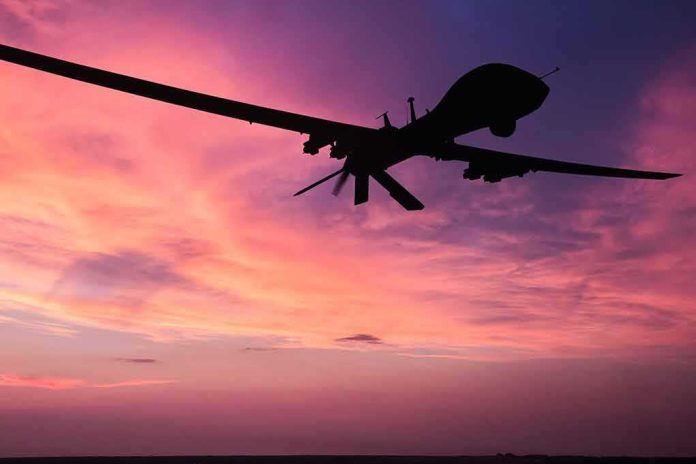
Over 350 unauthorized drones have infiltrated U.S. military bases in 2024 alone, yet our armed forces remain hamstrung by outdated policies requiring proof of “hostile intent” before taking action.
Key Takeaways
- U.S. military bases faced more than 350 unauthorized drone incursions in 2024, prompting House Republicans to demand urgent action from federal agencies.
- Current regulations require base commanders to confirm “hostile intent” before responding to drone threats, a standard lawmakers consider dangerously outdated given the speed of modern drone attacks.
- Only select federal agencies (Defense, Energy, Justice, Homeland Security) can legally interfere with drones, leaving critical infrastructure vulnerable.
- Republicans are demanding comprehensive documentation on counter-drone policies, incident reports, and plans for a unified response by July 10, 2025.
- The threat parallels drone warfare tactics seen in Ukraine and the Middle East, where simple drones have been transformed into deadly weapons.
America’s Military Bases Under Surveillance
A disturbing pattern of drone intrusions at U.S. military installations has caught the attention of Republican lawmakers who are demanding answers. Representative William Timmons (R-SC) and fellow Republicans on the Military and Foreign Affairs Subcommittee have highlighted a particular incident at Langley Air Force Base in Virginia where drones flew overhead for over two weeks in December 2023. This extended surveillance demonstrates a significant security gap that could be exploited by adversaries seeking to gather intelligence or potentially launch attacks on critical military assets.
The subcommittee has sent formal letters to the Departments of Defense, Transportation, and Justice highlighting their concerns about fragmented responses and outdated policies that create vulnerabilities in our national security framework. These lawmakers are insisting on a comprehensive review of current procedures and demanding documentation on interagency policies, incident reports dating back to January 2022, and plans for establishing a joint task force to address this growing threat.
“Recent high-profile incursions near sensitive military facilities, power infrastructure, and public events suggest that the current framework for domestic counter-drone operations remains fragmented and, in some cases, insufficiently agile to meet evolving threats,” lawmakers stated in their communication to federal agencies.
Outdated Rules in a New Era of Warfare
Current military protocols are dangerously behind the times. Base commanders must confirm “hostile intent” before taking countermeasures against drone incursions – a requirement that makes little sense when dealing with the lightning-fast capabilities of modern drone technology. This bureaucratic hurdle creates a window of vulnerability that could prove catastrophic if exploited by terrorists or foreign adversaries. The subcommittee has characterized the current response system as “improvised and bureaucratically delayed,” highlighting the urgent need for streamlined authority and enhanced data sharing between agencies.
The legal landscape surrounding drone countermeasures is equally problematic. Federal laws restrict most counter-drone activities to just a handful of agencies – the Departments of Defense, Energy, Justice, and Homeland Security. State and local law enforcement agencies, as well as private critical infrastructure operators, have extremely limited options for legally detecting and neutralizing drone threats, even when these drones directly threaten public safety.
“Capabilities for detecting and mitigating UAS may implicate federal criminal laws relating to surveillance, accessing or damaging computers, and damage to an aircraft,” according to an advisory guidance document.
Learning from International Conflicts
The urgency of this situation is underscored by lessons from ongoing conflicts abroad, where drones have transformed modern warfare. Russia’s 2022 invasion of Ukraine showcased the deadly potential of low-cost drone technology, with Iranian-made Shahed-136 “kamikaze drones” proving devastatingly effective on the battlefield. These GPS-guided weapons cost a fraction of traditional missiles yet can deliver precise, destructive payloads to military and civilian targets alike. The integration of artificial intelligence with drone technology is further magnifying these threats, enabling more autonomous and sophisticated attack capabilities.
President Trump’s administration is now confronted with the reality that America’s adversaries have observed these international developments and could potentially deploy similar tactics against U.S. interests. The proliferation of relatively inexpensive drone technology makes this threat particularly concerning, as non-state actors and even individuals with minimal resources could pose significant threats to national security.
“This is a rapidly evolving threat that requires a unified and proactive response,” stated the Republican lawmakers in their letter to federal agencies.
Building a Comprehensive Defense
The Republican-led effort is pushing for several specific reforms to enhance America’s counter-drone capabilities. These include expanding Title 10 Section 130(i) protections, clarifying FAA regulations to restrict drone flights over sensitive sites, and deploying advanced counter-UAS systems such as electronic warfare jammers and laser defense systems across U.S. military installations. Currently, these advanced protection measures are unevenly distributed, leaving some bases significantly more vulnerable than others.
“To better understand this issue, the Subcommittee is requesting documents and information concerning the federal government’s authorities and operational posture for countering unmanned aerial systems (cUAS) within the United States, with particular attention to discrepancies in how threats from unmanned versus manned aircraft are treated under current law and policy,” lawmakers explained.
The challenge facing the Trump administration is balancing legitimate commercial and recreational drone use with the pressing need for national security. The drone industry represents a significant sector of technological innovation and economic growth, but without proper safeguards, the same technology that delivers packages or captures aerial photography could be weaponized against American interests. Finding this balance requires sophisticated policy development that the Republican lawmakers are now demanding from relevant federal agencies.









